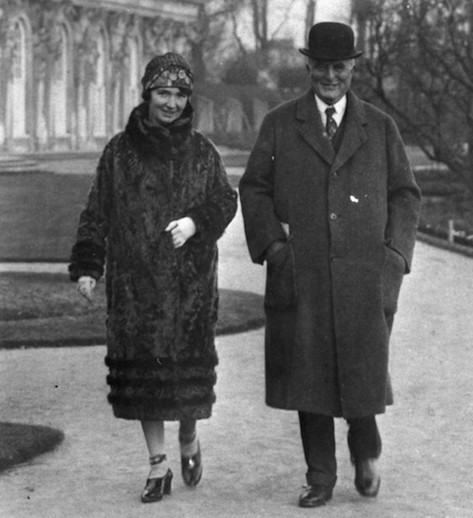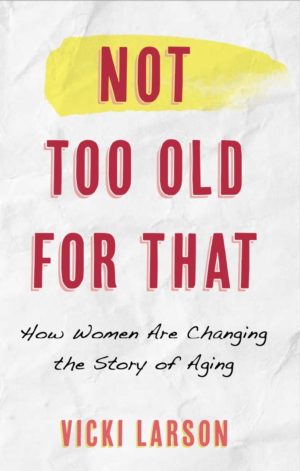When I married for the first time in the ’70s, I was still young, not even 21, and admittedly clueless about what I was getting myself into. He was cute, I was cute, we loved each other, we had two dogs, a cat and a snake, and we were happy hippies living (barely, on my Dairy Queen salary) in Colorado.
I knew nothing about marriage except my parents’ marriage, and that didn’t seem like something to model my own after; if anything, I wanted nothing like it. Knowing that, you’d think I would explore what, exactly, I was going to do differently, but like most 20-year-olds, I didn’t give marriage a lot of thought.

Margaret Sanger and second husband J. Noah H. Slee in 1927. The couple had a marriage contract in which they agreed to live apart.
But, other people were not only thinking about it, but creating their own arrangements, which I just learned about thanks to an interview Fresh Air‘s Terry Gross had with Gloria Steinem about her new memoir, My Life on the Road.
In the interview, Steinem mentioned an article in Ms. magazine about marital contracts.
What?
With a little research, I found the article, “How to Write Your Own Marriage Contract” by Susan Edmiston, which ran in the debut issue of Ms. magazine, in 1971, which was an insert in New York magazine (and created a huge kerfluffle). In it, Edmiston interviews two couples who created their own marriage contracts.
Why? Well, despite the cries of today’s men’s rights movement, marriage was not so great for women in the 1960s:
- We could be fired if we got pregnant (until 1978)
- Sexually harassed at work? Too bad (until 1977)
- We couldn’t get our own credit card (until 1972)
- We couldn’t refuse to have sex with our husband (until the mid-’70s in some states, in all 50 states in 1993)
- We couldn’t get a divorce without having to prove fault (until 1969)
Not surprisingly, it was the wives who insisted on the contracts to deal with what clearly were marital inequities.
One couple, the Shulmans, created a marital contract after they had kids, when their previously egalitarian partnership fell into old gendered patterns, which despite how far we’ve come, baby, since then, still occurs today. (It also was a way to salvage a marriage doomed for divorce, and was roundly mocked by Norman Mailer, Joan Didion and Russell Baker.)
The other couple started off with a contract, one that dealt with chores, cooking and finances. When their daughter was born, they renegotiated their contract again to include childcare, which the wife, psychologist Barbara Koltuv, admits was a struggle — one that I’ll bet most women can relate to:
The hardest thing was being willing to give up control. What we call responsibility is often control, power, being the boss. When I was really able to recognize that my husband’s relationship with Hannah is his and mine is mine, everything was all right. He’s going to do it differently but he’s going to do it all right. We’ve been teaching her all along that different people are different.”
I love that!
I also learned (too late for The New I Do: Reshaping Marriage for Skepics, Realists and Rebels, sadly) that marriage contracts between spouses date back farther than the ’60s and ’70s.
Social critic Mary Wollstonecraft was philosophically against marriage but married William Godwin in 1796 after they discovered she was pregnant (she died in childbirth six months later), yet they had a “highly unconventional marriage during which they lived far enough apart to permit the continuing exchange of letters.”
Abolitionist and suffragist Lucy Stone and activist Henry Blackwell created a contract when they wed in 1855, mostly in protest of coverture, in which women lost their legal existence to their husband once they married.
So did birth-control pioneer Margaret Sanger and her second husband, oil billionaire J. Noah H. Slee, whom she married in 1922. She wanted autonomy so they had a LAT, living apart together, arrangement, first in separate homes and then in separate parts of the same house.
Finally, Jackie Kennedy allegedly had a contract when she wed Aristotle Onassis in 1968, in which she declared her independence as well as separate homes and separate bedrooms within their shared homes. (It was also a safety marriage).
OK, we no longer have coverture and we have more egalitarian marriages than ever before, and thankfully women have financial independence. So do we really need individualized marital contracts?
You probably already know how I’ll answer but before you say yes or no, let’s look at what Edmiston includes in her article’s “utopian marriage contract” — agreements about birth control, having/adopting children, how children will be brought up, whose job will determine where and how the couple lives (including separate bedrooms or homes), how child care and housework will be divvied up, how they will handle finances, and sexual rights and freedoms.
Given how many of those are things couples still argue about today, and as women debate if they can have it all or just lean in, I scratch my head over why anyone, especially women, would be hesitant to create a plan that honored both spouses’ needs and expectations.
Unless perhaps the dirty secret is that we really don’t want marital equality. As Alix Kates Shulman, profiled in that 1971 Ms. article, wrote just recently:
The idea’s limited success is hardly surprising, given the economic, social, and psychological arrangements that continue to impede equality, in marriage and out. Such strains doomed my own marriage, along with half the marriages in America. Probably not until the polity is more child- and woman-friendly, not until men and women are equally valued — economically and otherwise — not until free or low-cost quality childcare is universally available, will the ideal of equality in marriage be other than radical.”
If Google analytics are correct, then the majority of my readers are women, especially young women — 20s to 40s. Could it be that we women don’t really want an equal partnership? Many married moms have said they’d prefer to work part time, echoing what the rest of society believes is ideal for kids, while the majority of men would just prefer to work outside the home. And maybe, as Koltuv discovered, it’s just too hard for women to give up control.
Can we have egalitarian marriages when one spouse works full time and the other works part time, when one spouse is unable or unwilling to give up control? Or does equality even matter as long as both spouses are happy with the arrangement — and society at large accepts it?
Want to individualize your marriage? Learn how by ordering The New I Do on Amazon, and, while you’re at it, follow TNID on Twitter and Facebook.

















Perhaps marriage should simply be abolished as a legal concept to become a mere religious ceremony, or a statement of intent, with no outright binding contracts except for agreements on community property and provisions for children.
Let each participant remain entirely responsible for their own lives and revisit the choice to stay with a single partner routinely with no severe consequences attached to splitting up.
Perhaps when men and women cannot claim each other (and all of each others’ property) legally there can be equality in purely ceremonial ‘marriage’. That should offer everyone involved all of the ‘control’ they can possibly stand.
Good points Anonymous. If one spouse agrees to work part time, and the other spouse is ok with that and takes on the bulk of the breadwinner role however, this simple decision that was made at the time to benefit the family will have far reaching and potentially life long consequences.
But wait, how can that be? Because should the couple have a divorce years down the road (and there is 50 percent chance this will happen), the breadwinner will be required to pay the part time working spouse a portion of his (her?) salary to equalize their incomes. In some states for life, in others for 1/2 the length of the marriage. Men have gone to jail for not making Spousal Support payments. Google it. Didn’t think there was a debtors prison in the US? Think again. This is the dirty secret few are talking about.
It’s state law in all 50 states though all states have statutes to follow which differ and are more or less severe.